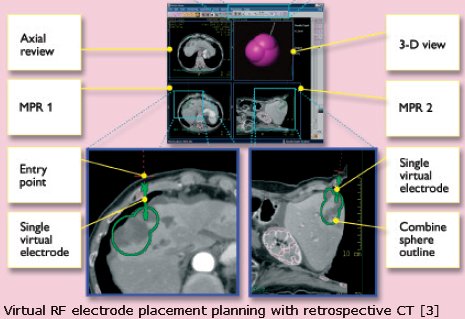Radio frequency ablation uses RF electrodes to elevate the temperature within a tumor to kill the cells, as previously described. By applying MDCT image guiding techniques to RFA, researchers are hoping to increase the treatable tumor size, reduce damage to surrounding tissue, and reduce procedure time.
The MDCT 3D coordinate system can improve pre-operative planning and increase the accuracy of electrode placement during the procedure. In the pre-procedure planning stage, a retrospective MDCT scan is used to place virtual RF electrodes. The software then generates isothermal contours, shown as green outlines in the image below, based on the configuration of electrodes and set frequency. The software also calculates heat sink caused by nearby blood vessels and the risk to adjacent tissues and organs. Other models are being developed to improve the procedure and perhaps automate electrode placement. For instance, heat maps can be used to plan tissue isolation procedures to minimize heat sink and minimize risk to vital organs. [3]

During the procedure, the planned path of the virtual electrodes are sent to a laser guidance robot. The robot then illuminates the planned trajectory. The MDCT can be combined with fluoroscopy to provide real time 3D visual feedback of the electrode placement, as shown in the image below. [3] The electrodes can also be equipped with an electromagnetic sensor at their tips for live tracking on a CT display. The real time 3D monitoring capabilities of the MDCT can also be used to monitor the effect on surrounding tissue and make adjustments during the treatment. [5]

After the procedure, the tumor is monitored with contrast CT scans. The size and possible proliferation of the tumor is monitored in the long term. Another advance that has recently been implemented is the combination of the PET and MDCT scans to more accurately track the tumor size post-procedure. The PET/CT uses functional imaging contrast media to more accurately visualize a heterogeneous tumor and determine the need for further treatments. [5]
Similar procedures may be applied to other high energy based ablation methods, such as cryoablation and high intensity focused ultrasound.
